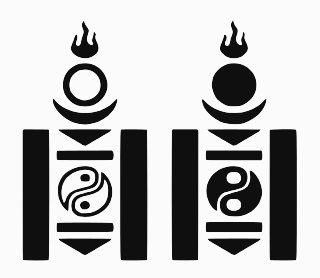
The Soyombo script is an abugida developed by the monk and scholar Zanabazar in 1686 to write Mongolian. It can also be used to write Tibetan and Sanskrit.

Kurukh, also Kurux, Oraon or Uranw, is a North Dravidian language spoken by the Kurukh (Oraon) and Kisan people of East India. It is spoken by about two million people in the Indian states of Jharkhand, Chhattisgarh, Odisha, West Bengal, Assam, Bihar and Tripura, as well as by 65,000 in northern Bangladesh, 28,600 of a dialect called Uranw in Nepal and about 5,000 in Bhutan. The most closely related language to Kurukh is Malto; together with Brahui, all three languages form the North Dravidian branch of the Dravidian language family. It is marked as being in a "vulnerable" state in UNESCO's list of endangered languages. The Kisan dialect has 206,100 speakers as of 2011.
The Laṇḍā scripts, is a Punjabi word used to refer to writing systems used in Punjab and nearby parts of North India. In Sindhi, it was known as 'Waniko' or 'Baniyañ'. It is distinct from the Lahnda language varieties, which used to be called Western Punjabi.
Mahajani is a Laṇḍā mercantile script that was historically used in northern India for writing accounts and financial records in Marwari, Hindi and Punjabi. It is a Brahmic script and is written left-to-right. Mahajani refers to the Hindi word for 'bankers', also known as 'sarrafi' or 'kothival' (merchant).

The Pallava script or Pallava Grantha is a Brahmic script named after the Pallava dynasty of Southern India (Tamilakam) and is attested to since the 4th century CE. In India, the Pallava script evolved from Tamil-Brahmi. The Grantha script originated from the Pallava script. Pallava also spread to Southeast Asia and evolved into local scripts such as Balinese, Baybayin, Javanese, Kawi, Khmer, Lanna, Lao, Mon–Burmese, New Tai Lue, Sundanese, and Thai.

The Tākri script is an abugida writing system of the Brahmic family of scripts. It is derived from the Sharada script formerly employed for Kashmiri. It is the sister script of Laṇḍā scripts. It has another variant Dogra Takri employed in Jammu region. There are numerous varieties present throughout Himachal Pradesh. Until the late 1940s, the adapted version of the script was the official script for writing Dogri in the princely state of Jammu and Kashmir. Throughout the history, different kingdoms of what now forms Himachal Pradesh used their own variety to maintain their records. The Takri script used in Sirmour in Himachal Pradesh and in the adjacent region of Jaunsar-Bawar in Uttarakhand has some distinction.
The rupee sign "₨" is a currency sign used to represent the monetary unit of account in Pakistan, Sri Lanka, Nepal, Mauritius, Seychelles, and formerly in India. It resembles, and is often written as, the Latin character sequence "Rs", of which it is an orthographic ligature.

The Gunjala Gondi lipi or Gunjala Gondi script is a script used to write the Gondi language, a Dravidian language spoken by the Gond people of northern Telangana, eastern Maharashtra, southeastern Madhya Pradesh, and Chhattisgarh. Approximately a dozen manuscripts in the script were recovered from Gunjala, a Gond village in Adilabad district of Telangana, by a team of researchers from the University of Hyderabad, led by Professor Jayadheer Tirumala Rao. The script and preliminary font were unveiled in early 2014.
Mahajani is a Unicode block containing characters historically used for writing Punjabi and Marwari.
Modi is a Unicode block containing the Modi alphabet characters for writing the Marathi language.
Siddham is a Unicode block containing characters for the historical, Brahmi-derived Siddham script used for writing Sanskrit between the years c. 550 – c. 1200.
Multani is a Unicode block containing characters used for writing the Multani alphabet, a Brahmic script used in the Multan region of Punjab and in northern Sindh in Pakistan. The script is now obsolete, but was historically used to write the Saraiki language.
The Pau Cin Hau scripts, known as Pau Cin Hau lai, or Zo tual lai in Zomi, are two scripts, a logographic script and an alphabetic script created by Pau Cin Hau, a Zomi religious leader from Chin State, Burma. The logographic script consists of 1,050 characters, which is a traditionally significant number based on the number of characters appearing in a religious text. The alphabetic script is a simplified script of 57 characters, which is divided into 21 consonants, 7 vowels, 9 final consonants, and 20 tone, length, and glottal marks. The original script was produced in 1902, but it is thought to have undergone at least two revisions, of which the first revision produced the logographic script.
Newa is a Unicode block containing characters from the Newa alphabet, which is used to write Nepal Bhasa.

Zanabazar's square script is a horizontal Mongolian square script, an abugida developed by the monk and scholar Zanabazar based on the Tibetan alphabet to write Mongolian. It can also be used to write Tibetan language and Sanskrit as a geometric typeface.
The Hanifi Rohingya script is a unified script for the Rohingya language. Rohingya today is written in three scripts, Hanifi, Arabic, and Latin (Rohingyalish). The Rohingya language was first written in the 19th century with a version of the Perso-Arabic script. In 1975, an orthographic Arabic script was developed and approved by the community leaders, based on the Urdu alphabet but with unique innovations to make the script suitable to Rohingya.
Indic Siyaq Numbers is a Unicode block containing a specialized subset of the Arabic script that was used for accounting in India under the Mughals by the 17th century through the middle of the 20th century.
Makasar is a Unicode block containing characters for Makasar script . The script was used historically in South Sulawesi, Indonesia for writing the Makassarese language.
The Elymaic alphabet is a right-to-left, non-joining abjad. It is derived from the Aramaic alphabet. Elymaic was used in the ancient state of Elymais, which was a semi-independent state of the 2nd century BCE to the early 3rd century CE, frequently a vassal under Parthian control, in the present-day region of Khuzestan, Iran (Susiana).

The Khema script, also known as Gurung Khema, Khema Phri, Khema Lipi, is used to write the Gurung language. Khema has been proposed for Unicode encoding as of 2011 and in 2021. The Language Commission of Nepal recognizes Khema as the official script of Gurung.







